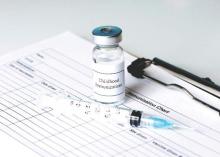BALTIMORE – A 3-year quality improvement (QI) measure succeeded in delivering the full human papillomavirus series to more than four out of five eligible boys.
The high rate of completed vaccinations – nearly triple the national average – was accomplished at a clinic with a high-need population that includes many newly-arrived immigrants, said Dr. Pilar Gonzalez, a pediatrician at Mount Sinai Health System, New York.
The improvements occurred against the backdrop of a clinic where physicians and staff already had a very strong commitment to achieving high immunization rates, Dr. Gonzalez said during a poster session at the annual meeting of the Pediatric Academic Societies. “We feel this is one of the most important things we can do for our population.”
To assess the efficacy of the pediatric primary care QI program, Dr. Gonzalez and her coinvestigators conducted a retrospective chart review to assess how many of the clinic’s male patients aged 13-17 years had initiated or completed the HPV series. The chart review looked back to Jan. 1, 2012, a full year before the QI initiative was implemented, and ended in December 2015.
Implementing the comprehensive QI program first involved engaging clinic staff, patients, and families through an educational curriculum that gave them facts about the HPV vaccine, and also provided information about oral, genital, and cervical cancer risks from HPV infection. The second arm of the QI project was outreach to the community. This included such interventions as Saturday vaccination clinics focused on delivering the full series to the target patients.
At the end of 2012, 50% of the 731 eligible male patients had received the full HPV vaccination series. One year later, 67% had completed the series and 24% more had started the series, for a total of 91% of eligible male patients who had received at least one HPV immunization. After 2 years of the QI project, a total of 93% of the eligible male patients had at least begun the HPV series.
The final data collection in December 2015, after a full 3 years of the QI project, showed that nearly all eligible male patients – 97% – had received at least one dose of the HPV vaccination.
“At the time we designed the QI project, we did not have the data” showing good efficacy with fewer doses than the full series of three immunizations, said Dr. Gonzalez, so the initiative was focused on getting all eligible adolescent males to completion of the series.
“Educating clinical staff and families, routinely offering the vaccine during clinic visits, sending patient reminders and recalls, and creating a catch-up immunization clinic helped increase the rate of HPV vaccination,” wrote Dr. Gonzalez and her coauthors, emphasizing that success of the effort in a high-need community was really a team effort.
Dr. Gonzalez and her coauthors reported no conflicts of interest.
On Twitter @karioakes


